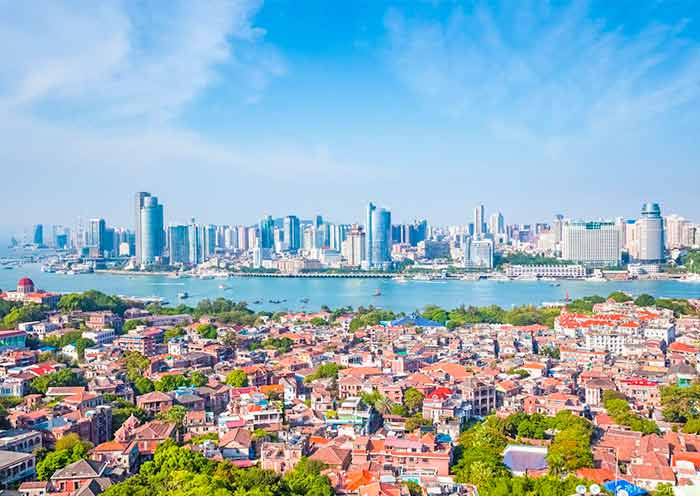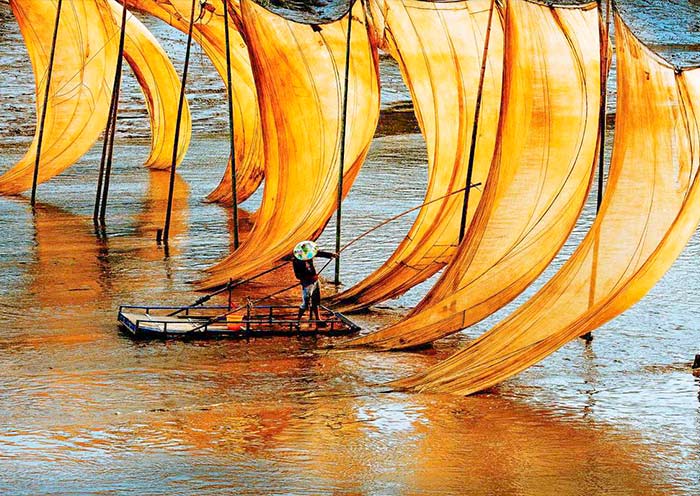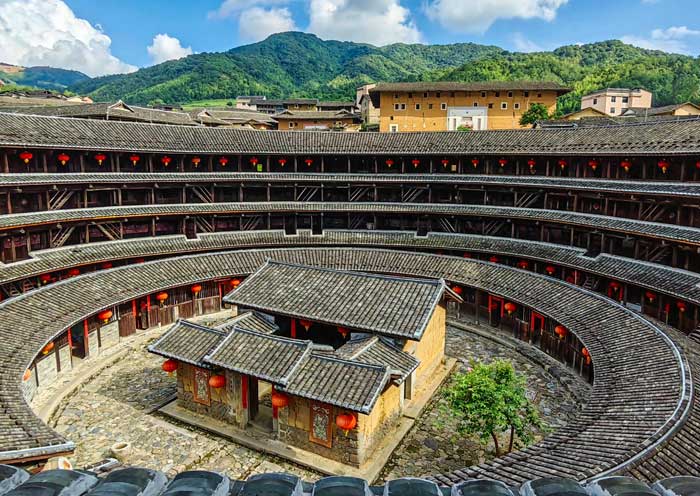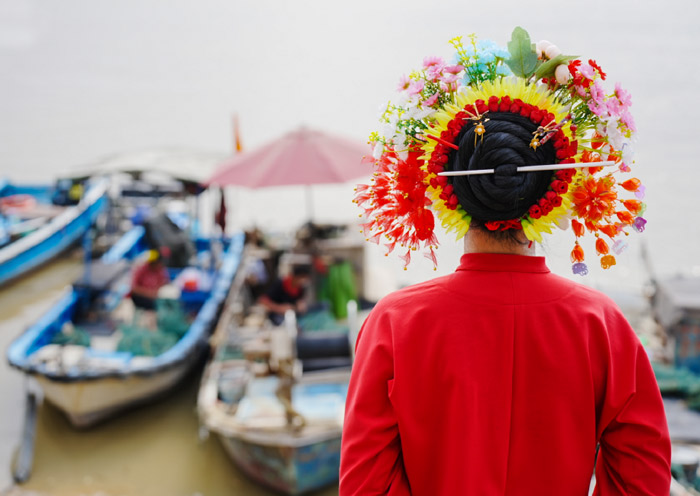Highly recommended for families seeking history and nature. The desert experience at Shapotou was unforgettable, and seeing the massive Western Xia Tombs gave us a real history lesson. The highlight was tasting the excellent wine at Xige Winery—a pleasant surprise in China's west! The tour was well-organized, and the guide and driver were exceptional, ensuring a smooth and enjoyable journey.
6 Best China Fujian Tours Packages 2025
Fujian Province, located on the southeastern coast of China, is known for its rich heritage, strikingly diverse landscapes, and historical significance. This storied land hosts an array of UNESCO World Heritage marvels, including three sites celebrated for their cultural significance: Gulangyu Island, remarkable as a historical international settlement; Fujian Tulou, an example of a building tradition and function exemplifying a particular type of communal living; the ancient city of Quanzhou, once a thriving port of the maritime Silk Road; Wuyishan Mountain earns a dual World Natural & Cultural Heritage site. In addition, Xiapu region is a lesser-known gem, often lauded as China's most picturesque coastline. It is a paradise for photographers, ranking among the nation's top 10 photography spots.
Planning your Fujian tour:
A typical Fujian tour takes around 5 days. Start your trip in Xiamen, and spend 1-2 days exploring the city. Then, allocate 1-2 days to visit the Fujian Tulou and another 2 days to explore Wuyishan. If you are passionate about photography, consider spending 2-4 days in Xiapu . If you are more interested in culture and history, plan 1-2 days to visit Quanzhou.
Asia Odyssey Travel offers a variety of Fujian Tours tailored to different interests:
For History and culture enthusiasts, Quanzhou was one of the most significant ports in the world during the Song and Yuan dynasties, serving as a major hub on the Maritime Silk Road.
Architecture enthusiasts will delight in 200 historical structures in different architectural styles of Xiamen's Gulangyu and marvel at the Fujian Tulou, which showcases the distinctive circular and rectangular earthen dwellings of the Hakka community.
Photographers looking for stunning natural landscapes will be drawn to Xiapu, where the complex arrangements of bamboo poles, fishing nets, and the routine of local fishermen offer endlessly captivating scenes.
Nature lovers and tea enthusiasts would likely be drawn to Wuyishan Mountain for its danxia landform, Neo-Confucianism culture, and the famed Da Hong Pao tea plantations.

"Excellent Tour, best experience"
"A unique experience despite a difficult context thanks
to an experience team of organisers"
- Top 6 Fujian Tours
- Fujian Photograph Tours
- Articles & Planning
Top 6 Fujian Tours
Explore the rich cultural tapestry and enchanting landscapes of Fujian Province with our top 6 Fujian tour packages. These packages cater to various durations, ranging from 1 to 7 days. For a quick glimpse of Xiamen City, choose our 1-day tour. If you have more time, spend 2-4 days to discover the highlights of both Xiamen and Fujian Tulou. If you want to include Wuyishan in your itinerary, our 5-day tour is the perfect choice. For photographers, our 7-day tour captures the essence of Fujian, from the historical Tulou to the breathtaking Xiapu mudflat. It offers opportunities to capture stunning sunrises, enchanting sunsets, and the unique lifestyle of the coastal communities.
Fujian Photograph Tours
For photography enthusiasts looking to capture the picturesque landscapes of Fujian, two specialized Fujian Photograph tours are offered: 7-Day Xiamen Tulou Xiapu Photography Tour combines the architectural marvels of the Hakka Tulou with the natural beauty of Xiapu's mudflats, perfect for capturing the region's cultural and scenic diversity. 4-Day Photography Xiapu Mudflat tour focuses solely on Xiapu, this tour is designed for photographers eager to shoot the stunning interplay of light, water, and traditional fishing life over several days. Tailor your trip to your preferences and discover the captivating highlights of Fujian at your own pace!
Fujian Heritage Tours
The Fujian Heritage Tours offer an immersive experience into the rich cultural and natural heritage of Fujian Province including the world architecture exhibition of Gulangyu Island (world cultural heritage site), the unique structures of Fujian Tulou (world cultural heritage site ), the majestic landscapes of Mt. Wuyishan (world natural and cultural heritage site), the historic city of Quanzhou (world cultural heritage site). Each site provides a window into the diverse tapestry of Fujian's history, culture, and natural splendor.
Fujian Tours Planning & Useful Articles
Are you planning your trip to Fujian, China? We understand that organizing a memorable tour can be overwhelming. Fear not! Our extensive collection of Fujian travel resources is here to assist you. Dive into our latest articles covering topics such as itinerary planning, top attractions, things to do, the best time to visit, and frequently asked questions about travel in Fujian. Contact us today to kickstart your tour and uncover the unparalleled beauty of this captivating province. View the complete Fujian Travel Guide now for a comprehensive experience.
Fujian Tours FAQs - Plan Your Fujian Tours Worry-Free
-
 1. How many world heritages in Fujian?
1. How many world heritages in Fujian?
Fujian Tulou: A series of large, multi-story earthen buildings constructed for defensive purposes by the Hakka people. They were inscribed as World Heritage Sites in 2008.
Mount Wuyi: Recognized for its exceptional biodiversity and significance in the development of Neo-Confucianism, it was inscribed in 1999 for both its cultural and natural values.
Quanzhou: Emporium of the World in Song-Yuan China. This site was inscribed on the UNESCO World Heritage List in 2021. It comprises 22 sites in the city of Quanzhou that reflect its history as a maritime emporium during the Song and Yuan dynasties, illustrating the city's intercultural dialogue.
Gulangyu: a Historic International Settlement. This island off the coast of Xiamen was inscribed as a UNESCO World Heritage site in 2017. It is known for its blend of different architectural styles and for being an important port of international trade in Fujian Province in the 19th and early 20th centuries.
-
 2. Why is Quanzhou named Zaiton?
2. Why is Quanzhou named Zaiton?
Quanzhou of Fujian province is believed to be named Zaiton due to its pronunciation in Arabic and Persian languages during the medieval period. The name Zaiton is derived from the Arabic word "Zaytun," which means "Erythrina tree." It is said that the city was called Zaiton due to the abundance of Erythrina trees in the region during ancient times. Over time, the name Zaiton evolved into Quanzhou of China as the city's name in Chinese.
-
 3. What is Xiamen famous for?
3. What is Xiamen famous for?
Cultural Melting Pot Xiamen's history as a trading port has led to a mix of different cultural influences, including European architecture on Gulangyu Island, which is a UNESCO World Heritage Site. This cultural diversity is evident in the city's art, architecture, and cuisine.
Scenic Coastlines and Natural Beauty The city offers beautiful beaches and scenic coastlines. The island geography of Xiamen itself, with its pleasant climate, makes it a relaxing getaway from the bustle of mainland China.
Rich Historical Heritage From the ancient Nanputuo Temple to the historic Hulishan Fortress, Xiamen has a wealth of historical sites that tell the story of China's maritime history and cultural development.
Lively Urban Atmosphere Despite its historical charm, Xiamen is also a modern, vibrant city. Zhongshan Road, for example, is a bustling pedestrian street with shops, street food, and a lively atmosphere.
Culinary Delights The city is famous for its delicious Fujian cuisine, which is one of the eight great traditions of Chinese cuisine. It's particularly well-known for its seafood dishes and various snacks.
Gateway to Fujian Province Xiamen can be a starting point for exploring the wider Fujian province, discovering the amazing world cultural heritage site of Fujian Tulou, the majestic landscapes of Mt.Wuyishan (world natural and cultural heritage site), the historic city of Quanzhou (world cultural heritage site), or the mesmerizing beauty of Xiapu (photographer's heaven).
-
 4. What to do on Gulangyu Island?
4. What to do on Gulangyu Island?
Explore the Architecture: Wander around and admire the unique mix of architectural styles from around the world. The island has been designated a UNESCO World Cultural Heritage site, known as World Architecture Exhibition.
Shuzhuang Garden: Visit the beautifully landscaped Shuzhuang Garden, initially a private villa, but now open to the public.
Sunlight Rock: Climb to the highest point on the island, Sunlight Rock, for panoramic views of Xiamen and the South China Sea.
Piano Museum: Check out the Piano Museum in the Shuzhuang Garden, which showcases a collection of antique pianos from around the world. Gulangyu is known as the "Island of Music".
Beaches: Relax on one of the island’s small beaches. Although they may not be ideal for swimming, they are perfect for a peaceful stroll or a quiet moment by the sea.
Local Cuisine: Sample local snacks and dishes such as seafood, oyster omelet, and the unique peanut soup.
-
 5. What is Fujian Tulou? Where is Fujian Tulou?
5. What is Fujian Tulou? Where is Fujian Tulou?
Fujian Tulou refers to a type of traditional Chinese residential building found in the Fujian province of China. These Tulou buildings are large, fortified structures made of earth, wood, and other materials. They were primarily built by the Hakka people, a group of people in southern China known for their unique culture and architecture.
Fujian Tulou can be found in various counties and villages across the Fujian province. They are typically located in Nanjing County and Yongding County which are rural areas, nestled amidst the scenic landscapes of mountains, rivers, and fields. Some well-known Tulou clusters include Chengqi Building, Tianluokeng Tulou Cluster, Hekeng Tulou Cluster, Gaobei Tulou Cluster, and Chuxi Tulou Cluster. These clusters offer visitors the opportunity to explore multiple Tulou buildings and experience the rich cultural heritage of the region.
-
 6. How to plan a Fujian Tulou tour?
6. How to plan a Fujian Tulou tour?
To plan a Fujian Tulou tour, consider starting from Xiamen, a convenient gateway to the region. Research reputable tour operators or hire a local guide who can assist with transportation, accommodation, and itinerary planning. Be sure to allocate enough time to visit multiple Tulou clusters, explore the surrounding villages, and immerse yourself in the local culture.
You can take 1 Day Nanjing Tulou Tour to explore the Tianluokeng Tulou Cluster, Yuchang Building, Taxia Village, and Hekeng Tulou Cluster. You can also take another 1 Day Yongding Tulou Tour to discover the Gaobei Tulou Cluster, Chengqi Building, Qiaofu Building, Chuxi Tulou Cluster, Jiqing Building, and Shanqing Building. You can also take a 2-Day Hakka Tulou Tour to visit both Nanjing Tulou and Yongding Tulou for an in-depth tour according to your time and interests. Sure, if you love Tulou so much you can customize your Tulou tour with more days. Immerse yourself in the history, architecture, and cultural heritage of Fujian Tulou, interact with the locals, and savor the unique experience of this remarkable destination.
-
 7. What is Xiapu known for?
7. What is Xiapu known for?
Xiapu is known for its stunning mudflats, which are considered some of the most photogenic in China. The area is famous for its picturesque landscapes, fishing villages, traditional fishing practices, and unique tidal patterns.
-
 8. What are the must-visit attractions in Wuyishan?
8. What are the must-visit attractions in Wuyishan?
The must-visit attractions in Wuyishan include the Wuyi Mountain Scenic Area, which is known for its stunning landscapes and the Nine Bend Stream. Other highlights include the Wuyi Palace, Tianyou Peak, Water Curtain Cave, Jiuqu Stream, and the Dahongpao Tea Plantation.
Latest Fujian Tours Reviews from Our Customers

Aisha
Malaysia
Destination(s): Ningxia
Date of Experience: Sep 02, 2025
Tour Customized by: Nicole
You May be Interested in This Tour: 5 Days Classic Ningxia Tour - Shapotou Desert, Yellow River & Lost Kingdoms

Emily Johnson
USA
Expert guides and seamless logistics made our trip truly exceptional. Highly recommended! The Tengger Desert's colorful lakes were a surreal highlight after an unforgettable night camping under Shapotou's starry sky. The history, wine, and off-roading created a perfect, diverse adventure.
Destination(s): Ningxia
Date of Experience: Oct 09, 2025
Tour Customized by: Anthony
You May be Interested in This Tour: 6 Days Ningxia Odyssey Tour: Desert Camping & Off-road to Colorful Lakes

Ryan Tan
Singapore
The perfect mix of history, wine tasting, and desert adventures, especially camping in Shapotou under the stars. Highlights included the stunning Western Xia Tombs and Xige Winery. Truly unique and well-organized—highly recommended!
Destination(s): Ningxia
Date of Experience: Jun 12, 2025
Tour Customized by: Danny
You May be Interested in This Tour: 6 Days Ningxia Wine Tour with Desert Camping in Shapotou
- United States (+1)
- Australia (+61)
- Singapore (+65)
- Malaysia (+60)
- Philippines (+63)
- Canada (+1)
- Italy (+39)
- Indonesia (+62)
- United Kingdom (+44)
- Spain (+34)
- Mexico (+52)
- Hong Kong (+852)
- Thailand (+66)
- United Arab Emirates (+971)
- New Zealand (+64)
- South Africa (+27)
- Germany (+49)
- Brazil (+55)
- India (+91)
- France (+33)
- Vietnam (+84)
- The Netherlands (+31)
- Saudi Arabia (+966)
- Ireland (+353)
- Argentina (+54)
- Switzerland (+41)
- Romania (+40)
- Pakistan (+92)
- Japan (+81)
- Portugal (+351)
- Bangladesh (+880)
- South Korea (+82)
- Puerto Rico (+1)
- Türkiye (+90)
- China (+86)
- Belgium (+32)
- Qatar (+974)
- Greece (+30)
- Taiwan (+886)
- Austria (+43)
- Poland (+48)
- Israel (+972)
- Chile (+56)
- Sri Lanka (+94)
- Nigeria (+234)
- Peru (+51)
- Colombia (+57)
- Hungary (+36)
- Nepal (+977)
- Denmark (+45)
- Bulgaria (+359)
- Norway (+47)
- Slovenia (+383)
- Sweden (+46)
- Kuwait (+965)
- Costa Rica (+506)
- Ecuador (+593)
- Venezuela (+58)
- Malta (+356)
- Croatia (+385)
- Tunisia (+216)
- Czechia (+420)
- Mongolia (+976)
- Bahrain (+973)
- Mauritius (+230)
- Papua New Guinea (+675)
- Cambodia (+855)
- Dominican Republic (+1)
- Luxembourg (+352)
- Finland (+358)
- Guatemala (+502)
- Myanmar (+95)
- Maldives (+960)
- Slovakia (+421)
- Laos (+856)
- Serbia (+381)
- Brunei (+673)
- Oman (+968)
- Macao (+853)
- Panama (+507)
- Morocco (+212)
- Jordan (+962)
- Georgia (+995)
- Fiji (+679)
- Bolivia (+591)
- Lithuania (+370)
- Bahamas (+1)
- Cyprus (+357)
- Latvia (+371)
- Bhutan (+975)
- Iraq (+964)
- Iran (+98)
- Kenya (+254)
- Jamaica (+1)
- Zimbabwe (+263)
- Azerbaijan (+994)
- Uruguay (+598)
- Estonia (+372)
- Andorra (+376)
- Cameroon (+237)
- Ghana (+233)
- Kazakhstan (+7)
- Nicaragua (+505)
- Egypt (+20)
- Russia (+7)
- Albania (+355)
- Réunion (+262)
- Montenegro (+382)
- Algeria (+213)
- Afghanistan (+93)
- Martinique (+596)
- Uganda (+256)
- Honduras (+504)
- North Macedonia (+389)
- Trinidad and Tobago (+1)
- Suriname (+597)
- Antigua and Barbuda (+1)
- Zambia (+260)
- Ukraine (+380)
- Armenia (+374)
- Barbados (+1)
- Belarus (+375)
- Palestine (+970)
- Lesotho (+266)
- Moldova (+373)
- Ethiopia (+251)
- French Polynesia (+689)
- Gambia (+220)
- Guam (+1)
- Gibraltar (+350)
- Isle of Man (+44)
- New Caledonia (+687)
- El Salvador (+503)
- Comoros (+269)
- Seychelles (+248)
- Chad (+235)
- Samoa (+685)
- Cook Islands (+682)
- Palau (+680)
- Paraguay (+595)
- DR Congo (+243)
- Solomon Islands (+677)























